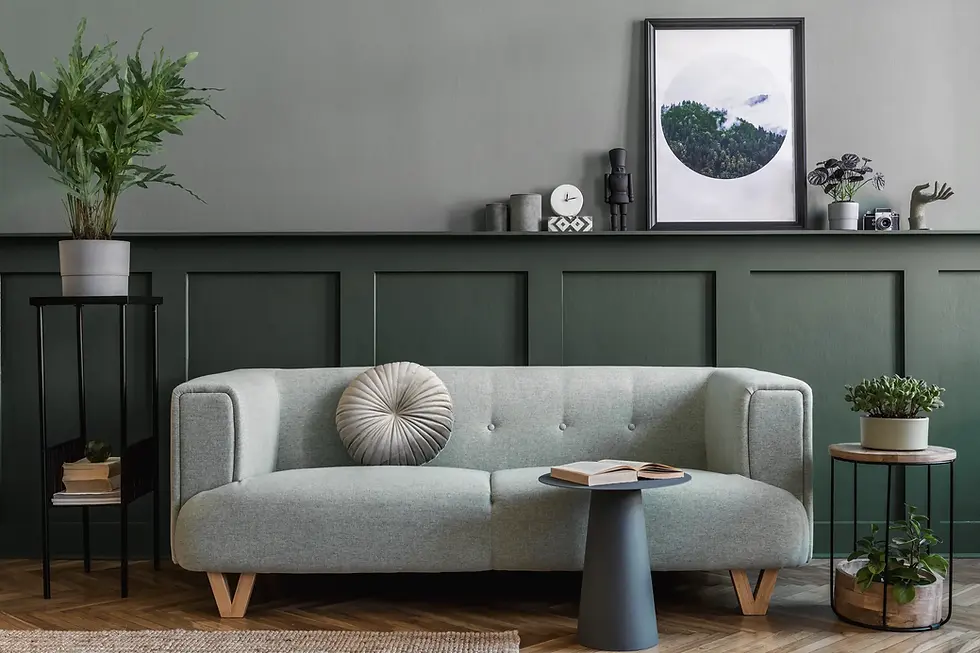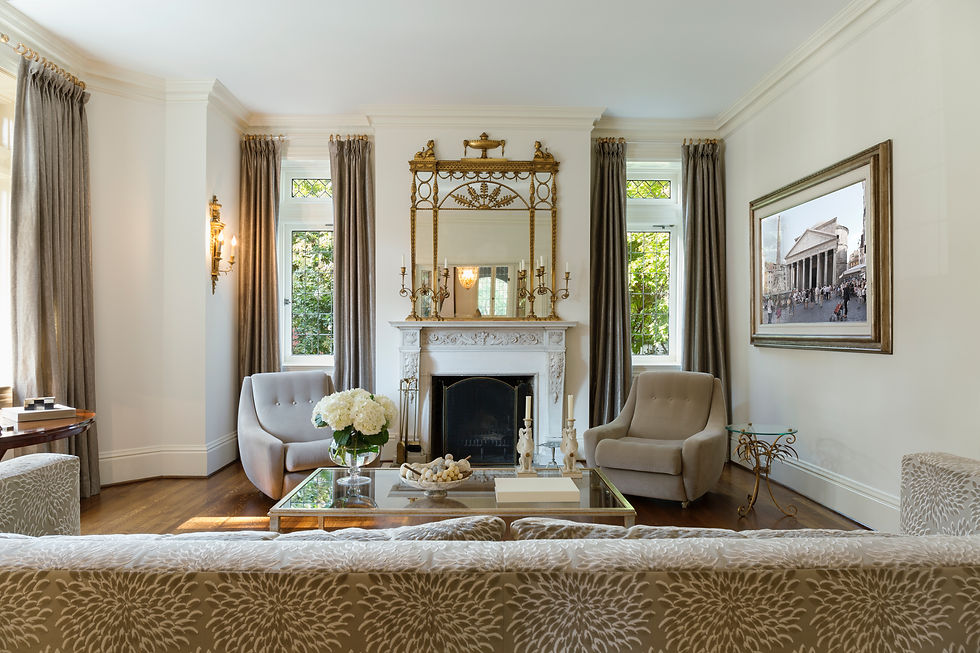Accent Wall: How to Transform a Room Without Renovating
- Ирина Колб

- Aug 31
- 6 min read
Updated: Oct 1
Big changes don’t always need big budgets. An accent wall is the easiest DIY upgrade that delivers maximum impact with minimum effort. One wall, one weekend — and your room feels brand new.
Ready to try it? Let’s break down how to spot the perfect wall, pick the right style, and build it out — all without hiring a contractor.

Step 1: Choosing the Right Wall
The right wall makes all the difference. Not every surface should stand out — but the right one can instantly set the tone for the whole room.
Here’s how to spot it:
Stand at the entry point. The wall you see first when you walk into the room is often the strongest candidate — it naturally commands attention.
Use existing focal points. Walls behind a bed, sofa, or dining table already act as a frame for the furniture, making them ideal for accent treatments.
Avoid distractions. A wall broken up by doors, windows, or vents is already visually busy and difficult to design around. Choose a surface with enough uninterrupted space to make an impact.
Quick tip: Before you start, test your idea with painter’s tape. Mark simple shapes or sections right on the wall. This way you’ll see if the layout feels balanced before painting or adding any panels.
Step 2: Choose Your Accent Style
Once you’ve found the right wall, the next step is choosing how to make it stand out. There isn’t one “correct” way — that’s the beauty of accent walls.
Some approaches are quick and simple, others require a bit more time and tools. What matters is giving the wall a look that feels different enough to stand out — yet still blends naturally with the rest of the room.
Here are five proven ways to transform an accent wall at home. Each option has its own style, level of effort, and set of tools. Pick the one that matches your space — and your DIY comfort level:
Painted Accent Wall with Bold Color
If you want to add contrast or a focal point without extra construction work, painting one wall is a great solution. The key is to choose a color that doesn’t clash with the existing palette but complements it instead.
Popular designer approaches to color selection
Deep navy works best in interiors with cool neutrals — gray, white — as well as with décor elements in graphite or metallic finishes. In warm beige rooms, this color can feel too heavy.
Warm terracotta pairs beautifully with soft cream and light beige tones, as well as with natural wood. It adds depth and coziness while highlighting a warm color scheme.
Sage green looks especially good alongside soft neutrals — beige, ivory, light gray — and natural textures like linen, cotton, or rattan. It helps create a balanced atmosphere without strong contrast.
Keep in mind: Dark paint colors need the right technique to avoid streaks and patchy spots. We cover it step by step in this guide: How to Paint Dark Walls and Get a High-End Look.

Wood Accent Wall (Slats, Panels, or Shiplap)
A wood accent wall is a great choice when you want more than just a color change. Wood brings depth, texture, and a handcrafted feel that paint or wallpaper alone can’t provide.
Designer tips for using wood accent walls:
Vertical slats — a smart solution if the room feels low. They draw the eye upward and make the ceiling appear higher.
Horizontal planks — especially effective in hallways. They visually widen the walls and make the space feel more balanced.
Shiplap or flat panels — the best option if your walls aren’t perfectly smooth. They hide small imperfections and create a clean backdrop that works well in Scandinavian, farmhouse, or transitional interiors.

Gallery Wall
A gallery wall is a simple way to fill empty space and give a room a finished look without major renovations.
Where a gallery wall works best:
Above furniture — a great choice for the area above a sofa, bed, or console table. The frames visually connect the furniture with the wall, making the interior feel more cohesive.
In hallways or along staircases — brings life to long, plain walls and adds movement to the space.
Combined with mirrors — mirrors break up the rows of frames and reflect light, helping smaller rooms feel brighter and more open.
How to keep it balanced: use frames in one color family (black, wood, or white) or limit the artwork to a few tones. This prevents clutter and creates a clean, curated look.

Wallpaper or Fabric Accent Wall
Wallpaper is a way to add an accent without major renovations. But keep in mind: installation always requires care, especially if you want the wall to look flawless.
How different materials perform during installation:
Non-woven wallpaper — the easiest option for accent walls. Unlike other types, the paste is applied only to the wall, not the sheets themselves, which makes installation cleaner and much simpler.
Vinyl wallpaper — dense and durable. Thanks to their thickness, they lay more evenly, seams are less visible, and the material doesn’t tear easily. They can hide small surface irregularities or fine cracks, but they’re heavier to work with and require more effort.
Paper wallpaper — the most affordable, but harder to install and quick to wear out. Any wall imperfections will be noticeable.
Fabric panels — take longer to install and require precision, but they create a premium look and add softness to the space.
Install tip: Start in the middle of the wall and work outward to keep alignment straight.

Built-In Wall Features (Shelves, Framing, Niches)
Such elements turn a plain wall into a functional and expressive centerpiece of the room. They combine décor with practicality and make the interior look more organized.
Where they work especially well:
Shelves — a place for books, plants, or décor without adding extra furniture. A simple way to bring practicality and lightness.
Framing — especially useful around a TV: the screen stops looking like a black box and becomes part of the overall design.
Niches — provide additional areas for storage or décor. With lighting, they transform into a striking accent that sets the mood.
Tip: such elements work best where you want to combine a clean look with functionality — for example, in living rooms, small apartments, or modern minimalist interiors.

Step 3: Choose by Mood, Not Just Looks
Still not sure which route to take? Let the feeling you want in the room guide your design.
You want a room that feels... | Try this |
Clean and quiet | Vertical wood slats, soft paint |
Industrial and bold | Brick panels, matte black, concrete textures |
Warm and personal | Gallery wall, fabric panels |
Elegant and structured | Moldings + color, two-tone paint |
Airy and natural | White shiplap, light wood tones |
No wrong answer — only what works best for your tools, your space, and your goals.
Common DIY Mistakes to Avoid
Even a good accent wall idea can fall flat if you skip the basics. Here are the most common mistakes — and how to sidestep them:
Overloading the wall — If you already plan to hang art or a gallery, keep the paint simple. Let one element do the heavy lifting.
Too many “special” walls — A single feature wall has impact; making every wall compete for attention just creates noise.
Skipping prep — Dust, uneven drywall, or bad lighting will show through no matter how good your paint or panels are. Take the time to smooth and clean first.
Rushing decisions — Live with a paint sample or wallpaper swatch for a couple of days. Seeing it in different light helps you make the right call.
Final Thoughts: Big Change. Small Commitment.
Accent walls are a smart DIYer’s secret weapon. They don’t cost much, but they shift everything.
They let you experiment with color, texture, pattern — without redoing the whole room. And they give your space that satisfying feeling: “Yeah, I made this better.”
No need for big budgets or big teams — just good tools, sharp eyes, and a little confidence.
If you ever want to go from DIY to done for you, our team at Tools and Hands can help.
Whether it’s slat walls, painting, drywall, or full installation — we’re here to make it easy. Book your free estimate


